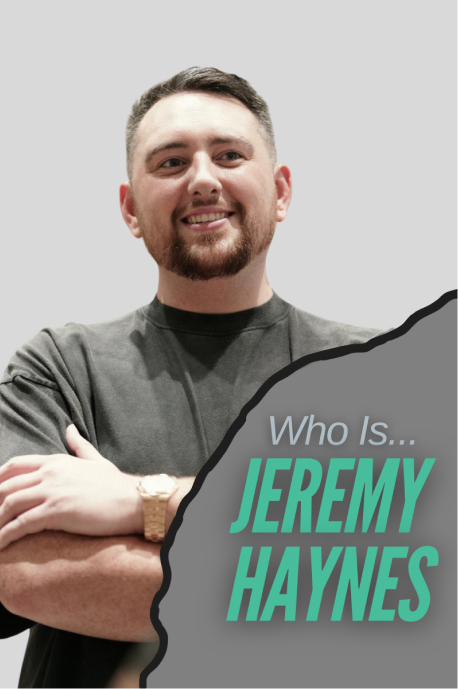I hope you enjoy reading this blog post. If you want my team to just do your marketing for you, click here.

I hope you enjoy reading this blog post. If you want my team to just do your marketing for you, click here.
Author: Jeremy Haynes | founder of Megalodon Marketing.

Earnings Disclaimer: You have a .1% probability of hitting million dollar months according to the US Bureau of Labor Statistics. As stated by law, we can not and do not make any guarantees about your own ability to get results or earn any money with our ideas, information, programs or strategies. We don’t know you and, besides, your results in life are up to you. We’re here to help by giving you our greatest strategies to move you forward, faster. However, nothing on this page or any of our websites or emails is a promise or guarantee of future earnings. Any financial numbers referenced here, or on any of our sites or emails, are simply estimates or projections or past results, and should not be considered exact, actual or as a promise of potential earnings – all numbers are illustrative only.
Watch the full video breakdown on this topic here.
Every founder—yes, including the 1 % of women dialed in here—inevitably stands at the same fork: Do I sell to the rich or sell to the crowd?
That single decision defines:
Pick wrong or, worse, try to straddle both lanes, and every signal you emit turns to static. The masses smell elitism; the affluent smell desperation. Revenue flat-lines long before you discover why.
Not theory—real steakhouse napkin math.
A new friend, already pushing $700,000 a month and reaching 23 million eyeballs every thirty days, asked how to crack consistent $3–5 million months. On paper he looked unstoppable:
Sounds cohesive? Not remotely. Here’s the clash:
Result: the masses scream scam, the affluent scroll past, and growth stalls despite the founder’s outrageous credibility. Indecision at the fork is costing him millions—every month.
Main-street buyers don’t just need tactics; they require fundamental rewiring before your product can land. That includes:
If you skip that groundwork, results evaporate, refunds pile up, chargebacks climb, and the FTC practically receives an engraved invitation to audit your claims.
Mass-market high ticket lives and dies by third-party financing. Those lenders bulldoze 5–15 % off every sale. You can bake the spread into price—great, now your buyer’s deeper in debt—or eat the margin and watch net profits bleed.
Either path magnifies:
Scale to eight figures with the masses and prepare for:
Not everyone survives that grind. Many brilliant operators flame out long before their bank accounts fill.
Yes, mainstream content rakes in outrageous reach. Your TikTok may balloon from 300 K to 10 million views overnight. That dopamine spike fools founders into thinking big numbers equal big checks. They don’t—not until the audience can actually afford you.
Affluent buyers reflexively equate premium price with premium outcome. Too low and suspicion erupts:
“If it’s really transformative, why is it $10K instead of $100K?”
I learned that lesson the hard way after buying a $120K “bargain” Rolls-Royce Ghost. The car rattled, the driveshaft malfunctioned, and the dealer quoted $85K to bring it back to baseline. Cheap price, cheap product. I flipped it at a $37K loss.
Contrast that with the $300K Ghost Series II I scooped months later—under warranty, impeccable, effortlessly worth the sticker. Or the McLaren 750S Spider I paid $460K for: every expectation shattered—in the right direction. Premium price telegraphed premium certainty.
Rich buyers:
Any piece of content that starts with “Step 1: believe in yourself” sends them sprinting for the exit.
Quick heuristic:
The affluent view your coaching, software, or agency service through the same lens. Cheap is costly.
Most founders begin with “What should I build?” Wrong ladder. Flip it:
Outline in that order and complexity evaporates; revenue speeds up.
Serving both demographics simultaneously almost never works. But sequencing can double-dip cash without chaos.
Case in point: Tai Lopez.
The transitions appear like “breaks” to casual observers—but behind the curtain entire funnels, messaging frameworks, and conversion engines are rebuilt before each relaunch. Expect 6–24 months per phase if you want the same odds of success.
Hover at the fork and everything jams: content tone, price perception, funnel design, even your nightly stress levels. Commitment is the mother of scale.
If you thrive on volume, compliance chess, and the adrenaline of mass attention, embrace the general public. Armor up for hate mail and finance fees, and you can mint fortunes at Walmart-scale numbers.
If you crave lean calendars, six-figure wires, and conversations measured in strategy, pivot to the affluent. Speak their language, price accordingly, and a smaller tribe will overshadow the revenue of ten thousand dabblers.
Either path works—just not both at once. Decide, double down, and let the other lane disappear in your rear-view mirror.
Get richer.

Jeremy Haynes is the founder of Megalodon Marketing. He is considered one of the top digital marketers and has the results to back it up. Jeremy has consistently demonstrated his expertise whether it be through his content advertising “propaganda” strategies that are originated by him, as well as his funnel and direct response marketing strategies. He’s trusted by the biggest names in the industries his agency works in and by over 4,000+ paid students that learn how to become better digital marketers and agency owners through his education products.

Jeremy Haynes is the founder of Megalodon Marketing. He is considered one of the top digital marketers and has the results to back it up. Jeremy has consistently demonstrated his expertise whether it be through his content advertising “propaganda” strategies that are originated by him, as well as his funnel and direct response marketing strategies. He’s trusted by the biggest names in the industries his agency works in and by over 4,000+ paid students that learn how to become better digital marketers and agency owners through his education products.
This site is not a part of the Facebook website or Facebook Inc.
This site is NOT /endorsed by Facebook in any way. FACEBOOK is a trademark of FACEBOOK, Inc.
We don’t believe in get-rich-quick programs or short cuts. We believe in hard work, adding value and serving others. And that’s what our programs and information we share are designed to help you do. As stated by law, we can not and do not make any guarantees about your own ability to get results or earn any money with our ideas, information, programs or strategies. We don’t know you and, besides, your results in life are up to you. Agreed? We’re here to help by giving you our greatest strategies to move you forward, faster. However, nothing on this page or any of our websites or emails is a promise or guarantee of future earnings. Any financial numbers referenced here, or on any of our sites or emails, are simply estimates or projections or past results, and should not be considered exact, actual or as a promise of potential earnings – all numbers are illustrative only.
Results may vary and testimonials are not claimed to represent typical results. All testimonials are real. These results are meant as a showcase of what the best, most motivated and driven clients have done and should not be taken as average or typical results.
You should perform your own due diligence and use your own best judgment prior to making any investment decision pertaining to your business. By virtue of visiting this site or interacting with any portion of this site, you agree that you’re fully responsible for the investments you make and any outcomes that may result.
Do you have questions? Please email [email protected]
Call or Text (305) 704-0094